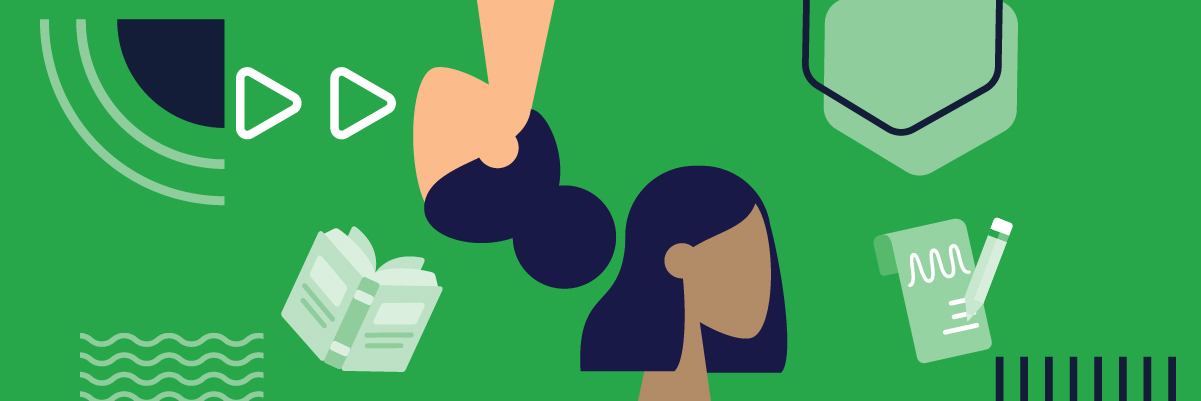Are you wondering how to give your content a boost and maybe incorporate something new? Maybe you’re wondering about styles of writing and what is a narrative writing? Narrative writing is the art of storytelling and it’s a fantastic tool for customer engagement. So let’s break down narrative writing a bit more and see how you can use it.
What is a narrative writing, exactly?
We love this question! So let’s get to it. Narrative writing is the art of storytelling, as we mentioned, but it’s so much more than that. We learn from MasterClass that a narrative is a form of storytelling that links events through the use of plot, structure, and concept. It usually has a clear beginning, middle, and end. There are four types of narrative, and you may find one or another more useful to your purpose. Let’s take a look:
Linear narrative
A linear narrative is a piece of work that tells a story in order. This is tougher than it sounds because there are no flashbacks, no excerpts from another time; it’s simply the chronological order. Think If You Give a Mouse a Cookie. These narratives are clear and easy to follow, but sometimes risk being a bit mundane. Timelines are simple. Some narratives may be mostly linear, but have a bit of nonlinear narrative thrown in, like Harry Potter. The story does have a beginning, middle, and ends, and mostly goes in clean order, but sometimes we get a glimpse of the past. Linear narratives are great for short works.
Nonlinear narrative
More common than we may think, nonlinear narratives are stories that may be told out of order, contain flashbacks or pieces from another time, or told by multiple narrators or viewpoints. They contain backstories and can create suspense and drama. Donna Tart’s The Secret History is a great example of this. Many films and novels are told in a nonlinear narrative.
Quest narrative
We love a great quest. Think Bilbo Baggins in The Hobbit or the great quest for the silver slippers and home in The Wizard of Oz. There is a clear goal and the main character, or characters, will go through whatever it takes to get there. Often these are quite descriptive and have a few smaller conflicts along the way to get to the main one.
Viewpoint narrative
These narratives are told from a specific viewpoint. Think Nick Carraway in The Great Gatsby or many blog writers in today’s world. We can see feelings and emotions and participate in their experiences firsthand through viewpoint narration.
Depending on your purpose, you may choose any of these narrative types. Knowing what is a narrative writing can help in your planning process and identify what you need to engage and appeal to your audience. Be careful not to get locked in, though. For instance, if you begin with one type and feel a shift towards another, don’t be afraid to let the writing go in that direction.
When can you use narrative writing?
If you are working on a film screenplay or novel, sure you’re going to use narrative writing. You’re telling a story, right? That’s a narrative. Short stories are narratives, too, but what is a narrative writing in other contexts? Let’s think about your blog, podcast, or website. There’s plenty of places here to incorporate narrative writing.
Blogs
Blogs are perfect places to use narrative writing. The TED Blog may be one of the best examples out there. Here, the authors tell their stories in short, concise, but captivating narratives that lure the reader in. In fact, Ted talks themselves are great examples of engaging narratives. These are viewpoint narratives and engage the audience. Because they are short and dynamic, there’s no time to lose attention. Blogs can have the same feel. Keep the narrative short, engaging, and direct. Yet, you can lace it with imagery and some dynamic writing. If you need a bit of help with your blogs, we’ve got some great advice, plus our freelancers would love to help! Sometimes you’ve got all the material, the ideas, and the vision, but you just need that extra help getting it down.
Podcasts
There are those podcasters who get on the air and just talk. They have the gift of gab and can speak coherently, logically, and engaging. Other podcasters like a script. And that’s a great place for narrative writing. You’re probably not going to read it verbatim, but it can be a great guide to your podcast storytelling. In fact, some podcasters have writers take on this part of their show, and they stick to the producing or hosting. Think about opening your show with a great narrative or adding a story along the way for a strong example. Whatever your podcast genre is, there’s probably a place for a lovely narrative.
Websites
A website is full of places for narrative writing. Who knew? Your website will certainly benefit from quality content, and there’s plenty of places to include it. Let’s first think about your About Me page. Sure, you could list some facts about yourself, tell where you live, and end with what drives you. However, what if you put it into a narrative? You open with you as a small child, dreaming of what you’re doing now. Then take your audience on your journey (hmmm…do we hear a quest calling) and end with the result we see on your website. You can share your drive, your motivation, your goals, even your struggles, cause we all have them, right? This is what your audience wants.
Another great place on your website for narratives is product descriptions. You can share a brief story of the development of a product and even narratives of how customers use them. If you provide a service, think about using narratives as well. We love incorporating narratives on a website to engage the audience and create a world, a community of stories, and immersive emotion.
Don’t be afraid to incorporate narrative into your written work. It adds a strong touch that will reach and connect your audience.

Key skills to writing narrative
When it comes to writing a narrative, strong work comes from a high-level skill set. Perhaps writing is your thing; maybe it’s not, but storytelling is. It takes both to create a strong narrative. For instance, an appealing narrative will use great vocabulary, be written for the audience, and contain emotion. Emotion is what brings an audience together, and stories can thrive and blossom when emotion is incorporated.
We mentioned vocabulary, let’s look a little deeper. Do you often find yourself turning to a thesaurus, trying to use “those” words? In reality, however, those words can clog up the flow of your writing. We love dynamic vocabulary, but clear, natural writing. It’s easy to stick in a big word, here and there, but it won’t always sound natural. Stick to vocabulary and language that is indicative of the tone and voice you’re striving for. A natural and organic rhythm and tone to your content will appeal to your audience. No one likes something that sounds phony and forced. And just as you want to steer clear from words that don’t sound like you, stay away from those overused words, like very and nice. They can dull down your narratives.
Another skill is keeping an appropriate length. Know where your content is going and who it’s reaching. If you are writing a post for your blog on sustainability, it can be longer than a product description for the new dog toy on your website. That’s where language comes in again. Keep it clear, keep it clean, and you’ll see your audience engage.
Reach out for help with your narrative
Now that we have a good understanding of what is a narrative writing, it’s time to assess if you’re going to take this on yourself or reach out for a bit of help. In fact, you can even do both.
Freelance writers
Freelance writers, like our top-notch pros at Bunny Studio, can help with your narratives in any capacity. Whether you’re writing for your blog, website, film script, or even a novel, we can help. Freelance writers are skilled in the nuances and intricacies of narrative writing from plotline to point of view. Don’t be afraid to enlist a writer or even a ghostwriter; your narrative will turn out sharp, dynamic, and engaging. And whether the narrative is for a script, a podcast, a story, or a website, there’s someone out there to take it on.
Freelance editors
Perhaps you’ve written your narrative but just want a good once over before you hit that publish key. A freelance editor can tweak your piece to give it all the oomph you’re aiming for. They’ll also make sure you don’t have grammatical, spelling, or punctuation mistakes and can check that your tone matches your audience and purpose. You can see, there’s a lot that goes into narrative writing beyond just telling a good story.
We would love to help, and our pro writers and editors are at the top of their game. We offer professional services for any of your writing needs.
The Bottom line on What is a Narrative writing
Narrative writing is the art of storytelling. Yet, it goes far beyond that. Sure, some of us are born storytellers, some not so much. Others are good at pieces and parts, but stumble when it’s time to put it all together. Never fear, though! We have you covered. We can help create and compose that dynamic narrative content for any purpose. Whether you are looking to refine your short story, create content for a podcast, or share your dream on your About Me page, we are here to help. You can easily hire a writer to fit your needs at Bunny Studio, and we’ll be with you all along the way. Let’s get some natural-sounding, engaging, dynamic narrative going and form those connections with our audience. Just reach out to us, and let’s get started!










